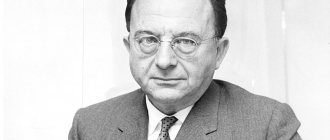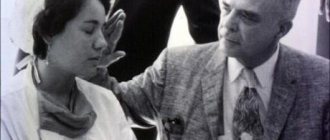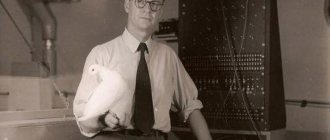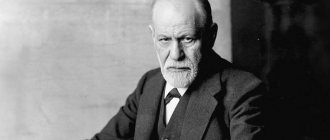Carl Ransom Rogers is a psychologist and leader of the humanistic direction of psychology. The uniqueness of his methods lay in their versatility and wide range of uses. Along with Abraham, Maslow developed the “I-concept” - this in psychology means the formation of personality in the process of human interaction with the social environment. The professor actively worked on the creation and development of person-oriented psychotherapy. He is recognized as one of the first representatives of humanistic psychology.
Brief description of the working method
The peculiarity of the methodology developed by Rogers is its universality. It can be used both for groups and for individual work, regardless of factors such as the type of human activity or religious views. In addition to the direction of impact, the method is distinguished by the fact that it can be used to resolve intrapersonal, interpersonal and even intergroup conflicts. The third area of Rogers' unique therapy is working with a wide range of client problems. These may be professional problems, difficulties in love and relationships, or other psychological difficulties. Carl Rogers paid particular attention to marriage and its alternatives.
The Rogers system was especially effective in interacting with children through play. Group therapy, the essence of which is to place a person in an artificially created group to observe his behavior, has also been successful.
Key Concepts
The meaning of personality (Personal power). A widely used name for a person-centered approach. It includes the locus of decision-making and control power.
Interpersonal knowing. In Rogersian psychotherapy, this concept refers to the practice of empathic understanding. Its goal is to understand the experience of another person as he himself experiences it; observance of objective correctness is not required.
Incongruence. Reluctance or inability to communicate accurately, inability to perceive adequately, or both. Inconsistency occurs when there are differences between experience, communication and understanding.
Objective knowing. Understanding at the social level. With its help, hypotheses, speculations and assumptions are tested in conditions of objective reality.
Field of experience. A subjective reality unique to each person, containing the events of his life and accessible to understanding. The field of experience may or may not correspond to objective reality. This is a person’s personal, separate inner world; it is subjective, selective and imperfect.
Fully functioning person. A person who is fully aware of his real self. Such a person is characterized by the following traits: he is open to experience, lives in the present, trusts his intuitive judgments and internal impulses. A person's confidence in his ability to make decisions applies to the whole person, not just the “intelligence.”
Meeting groups or Encounter groups (Process of encounter). In the groups that Rogers led or where he acted as an observer, the following sequence of actions was used. The group begins by treading water and exhibits initial resistance to exploring personality and expressing feelings. People exchange their feelings about the past. Negative feelings are most often expressed first. If the group manages to maintain unity, personally significant information becomes apparent. Both positive and negative feelings are directly expressed. As people express and respond to more emotions, healing capacity develops within the group. As a result of feedback from the group and its approval, people accept and approve of themselves.
Congruence. A state of harmony between communication, experience and understanding
If what a person expresses (communication), what happens (experience), and what a person pays attention to (awareness) are almost identical, then such a person has a high degree of correspondence.
Subjective knowing. Understanding whether a person hates, loves, enjoys, or despises another person, an event, or one's own experience
Such understanding can be improved by becoming aware of one's internal physical sensations. This is the ability to understand what is happening to the extent that one can act based on hints, follow intuition, without using obvious evidence.
Self-actualizing tendency. Part of a process common to all living things. In humans, it is expressed in the desire to activate and use all the abilities of the body. Self-actualization is the only motive postulated in Rogers' system.
Condition of worth. A type of behavior and attitude that denies some aspect of the self. A person considers this requirement necessary in order to win love and gain a sense of self-worth. Such limitations interfere with a person’s free behavior, hinder his maturity and full self-awareness. It leads to inconsistency and ultimately to rigidity of the individual.
Empathic understanding. The ability to accurately perceive other people's feelings. A necessary element in the cycle of self-correction and self-development, which helps people overcome internal barriers and facilitate their psychological growth.
“I” is the ideal self. The optimal self-concept of a person. Like the self itself, it is constantly changing. It can serve as an ideal to which a person strives, but at the same time it can hinder development if it differs greatly from current values and real behavior.
Biography
Rogers was born on January 8, 1902 in Illinois, in the Chicago suburb called Oak Park. Carl was the middle child, the fourth of six. He had four brothers and one sister. The Rogers family lived in prosperity, the father worked as an engineer, was able to reach some heights and financially provided for the family. In his early years, Rogers lacked for nothing. When the boy was 12 years old, he and his family went to live on a west Chicago farm, where he spent his youth.
Carl Ransom Roger always noted that he grew up in a prosperous family, where parents always loved children and were particularly sensitive. However, the only problem was the uncompromising religious position of the parents. Despite the fact that the children felt love and sincere emotions for mom and dad, with age, dogmatic adherence to fundamentalist views began to acquire many questions and misunderstandings on the part of the offspring.
School years
Carl Roger didn't have any good friends, only his brothers and sister. Therefore, the boy spent a lot of time reading, preferring to be alone with some adventure book. The love of reading and thirst for knowledge forced Rogers to grab hold of any literature, be it a dictionary, encyclopedia or a regular reference book. Despite his boring youth, the biography of Carl Rogers is quite bright and rich.
Carl noted that he never participated in school activities outside of class. During the entire period of study, he changed about three schools, in each of which he did not stay for more than two years. Living on a farm meant it was a short commute to school, leaving little time to participate in extracurricular activities. During his school years, the boy lived in so-called social isolation. But this did not prevent the child from studying excellently. Roger demonstrated outstanding results in English and Science.
Fully functional person
Rogers argued that all people can achieve their goals and desires in life. When they did this, self-realization occurred. People who are capable of self-actualization, who do not constitute all people, are called "fully functional people".
This means that a person has contact with the “here and now”, his subjective experiences and his feelings, and this is in constant growth and change.
Rogers viewed the fully functional person as an ideal that many people fail to achieve. It is wrong to think of it as if it is the end of life's journey; it is a process of change.
Rogers identified five characteristics of a fully functional person:
1- Experience discovery
These people accept both positive and negative emotions. Negative emotions are not denied, but explored (rather than resorting to ego defense mechanisms). If a person cannot open his feelings, he cannot open himself to actualize himself.
2- existential life
This consists of being in touch with the various experiences that happen in life, avoiding prejudices and prejudices. It involves the ability to live and fully appreciate the present without always looking to the past or the future, since the former is gone and the latter does not even exist.
This doesn't mean that we shouldn't learn from what happened to us in the past, or that we shouldn't plan things for the future. We just have to admit that the present is what we have.
3- Trust our body
You must pay attention to and trust your feelings, instincts, and gut reactions. We have to trust ourselves and do what we think is right, and this comes naturally
Rogers refers to the confidence we must have in ourselves in order to be in touch with self-realization.
4- Creativity
Creative thinking and risk-taking are characteristics of people's lives. This includes the ability to adjust and change in search of new experiences.
A fully functioning person, being in touch with actual renewal, feels a natural impulse to contribute to the renewal of those around him.
This can be done through creativity in the arts and sciences, through parental love, or simply by doing the best job possible.
5- Experimental freedom
Fully functional people are happy with their lives because they experience them with a true sense of freedom.
Rogers argues that a person who works fully recognizes free will in his actions and accepts responsibility for the opportunities provided.
For Rogers, fully functioning people are well adjusted, well balanced, and interesting to understand. Often these people get great things in society.
Free time
The time spent on vacation was also not exciting and interesting: every summer the boy worked on the farm until he sweated, so there was no talk of communicating with friends. If you believe the biography of Carl Rogers, it was thanks to this that he developed an unprecedented interest in studying nature.
In order to combine business with pleasure, he, while doing his parents’ chores around the house, wrote down his observations about plants and animals. This turned working until exhaustion into a kind of game. The boy collected and raised a certain type of moth and studied everything about them that a 14-year-old child could find at that time.
Childhood and youth
Carl Ransom Rogers was born in America at the beginning of the 20th century, his biography began on the outskirts of the largest industrial city. The village of Oak Park, located near Chicago, appeared on the map in the mid-1830s.
The ancestors of the future psychologist did not lack funds and were considered a religious, well-bred family. His father, an engineer at a construction company, and his mother, a professional housewife, pretended to be happy with the world around them and with themselves.
In fact, in the house where Rogers, his sister and four brothers grew up, there was a tense atmosphere due to the strictness of the adults. Children were not allowed to participate in entertainment events, so they did not have acquaintances or close friends.
I am the one on the far right.
Published by Carl Ransom Rogers Wednesday, June 21, 2021
Carl Ransom Rogers in childhood with his family
Carl Ransom compensated for his forced loneliness by reading fiction; this hobby suited the educated head of the family. Getting acquainted with the works of novelists and popular science works, the boy established contacts with imaginary people.
In the early 1910s, the parents became the owners of the farm, and after that the younger generation had a lot of worries. At the age of 12, Rogers began helping around the house and was involved in agricultural work.
Studying at a public school changed little in the child’s life; in the company of his classmates he was always considered a stranger. Dreams of a society in which one could realize oneself dimmed during this period and soon dissipated.
Despite this, the boy had an excellent knowledge of general education subjects and regularly received flattering reviews from his teachers. In three different educational institutions located far from home, Karl Ransom mastered English perfectly from books and articles.
In the summer, the teenager worked hard on the farm owned by his parents, and in his free time he studied scientific methods of labor. Of interest was the life of plants, insects, small animals, as well as everything that was included in the concept of the environment.
After graduation, Rogers and his brothers planned to start farming on the family estate. At the University of Wisconsin, at the Faculty of Agriculture, the young man communicated with teachers and people knowledgeable in this matter.
At a certain stage of his biography, he remembered his religious past and joined the organization of American Christians. The diligent student attended a conference in the capital of the People's Republic of China, where a fundamental life plan began to take shape.
The traditions of the Asian state changed views on society; upon returning to his homeland, Karl Ransom transferred to the history department. At the same time, he took an elective course in psychology, which absorbed all his attention in the next decades.
College at Columbia University became a new stage of education. There Rogers became interested in working with troubled, disadvantaged children. Having received a master's degree and defended his doctoral dissertation, the American finally left the control of his family.
University years
After graduating from school, Karl was firmly convinced that he would connect his life with agriculture and become a farmer. In 1919, Rogers went to study at the University of Wisconsin, following in his parents' footsteps. When determining the profile, the choice fell on scientific farming.
From his sophomore year, Rogers immersed himself in religion and was a regular at conferences held under the motto: “Instruct the world of our generation in the Christian faith.” As a result, after some time, the guy firmly decided to prepare to become a pastor.
World Student Conference
It was only in 1922 that something happened that completely changed the course of Rogers’ life. That year, the World Student Christian Federation conference was held in Beijing. Rogers, along with nine other students, was selected to travel to the event.
Karl spent almost six months abroad, where he studied not only religious, but also cultural relations, which were actually opposite to the established traditions in his own family. A long stay in the eastern part of the globe turned Rogers' world upside down. His views became more loyal and liberal, and the information he learned called into question the divinity of Jesus. We can say that this trip freed Karl from his religious parental “networks.”
The trip to the East became a new stage in the life of the future psychologist. He returned to Wisconsin and received a history degree in 1924. Rogers took only one psychology course (by correspondence).
Quotes
- “Many problems arise when we try to meet others' expectations instead of defining our own.”
- “Each of us consists of two separate parts, desperately trying to unite into one integrated whole in which the distinctions between soul and body, feelings and intellect would be erased.”
- “People who don’t believe in human kindness rarely experience it.”
- “What makes you think that someone should love you? Where is that written?!"
- “There may also be errors in the theories of authorities.”
New life
His studies came to an end, and Rogers decided to get married. His bride was Hlen Eliot, a classmate at Wisconsin whom Karl had known since childhood. After their engagement, the newlywed husband and wife went to New York to attend the liberal Union Theological Seminary. Life in New York impressed Rogers to the core, and he described it as exciting and soul-stirring. This move was a breath of fresh air: Karl found new friends, worked on ideas and fell in love with life and familiar things in a completely new way.
In seminary, he came to the conclusion that pastors and psychologists have a common goal, which is to help people in need. However, the fascination with religion gradually dissolved, giving way to disappointment and skepticism. During his senior year, Rogers transferred from theological seminary to Teachers College at Columbia University. There he received his education in the field of psychology, both clinical and pedagogical. Already in 1928, Rogers became a master, and in 1931, a doctor of science. Clinical psychology became an integral part of his life.
Work as a psychologist
After receiving his doctorate, Karl began working as a psychologist in New York City for the Society for the Prevention of Cruelty to Children. In fact, for the next 10 years he worked with disadvantaged children, understanding their problems. This experience seriously influenced the further development of the biography of Carl Rogers. The professor became the director of the Rochester Help Center, but was 100% sure that this position should belong to a psychiatrist, not a psychologist.
In 1939, Roger's work was published, which was called “Clinical Treatment of the Problem Child.” After publication, Karl was immediately offered a job at Ohio University as a professor in the psychology department.
Only a year passed, and in 1940 Rogers went to Columbia University to start his career path over a new leaf. This decision contributed to the recognition of the scientist’s merits in the field of just developing clinical psychology. He successfully recruited talented employees, published works, and shared his views on psychotherapy. Already in 1942, Rogers published the book “Counseling and Psychotherapy,” based on two years of work experience. In addition, the “self-concept” was developed (in psychology, this is an individual’s system of ideas about himself, a part of his personality that he is aware of, as mentioned above). This theory was developed with a well-known person in psychology - A. Maslow.
Criticism of Rogers' theory
Carl Rogers' theories have received much criticism, both positive and negative. To begin with, in connection with his person-centered therapy, his concept of human nature is criticized as a desire for goodness and health.
Just like Maslow's theories, Rogers' theories have been criticized for their lack of empirical evidence. A holistic view of humanism allows for many variations, but does not identify variables that are constant enough to be examined accurately.
Psychologists also argue that such an extreme emphasis on the subjective experience of the individual can eliminate the influence of society on individual development.
Some critics argue that the fully functional person Rogers talks about is a product of Western culture. In other cultures, such as Eastern cultures, the achievement of goals by groups is valued much more than the achievement of one individual.
Despite the criticism he received, Carl Rogers' theory of personality and his therapeutic methodology continue to gain followers and have become one of the most influential trends in the history of psychology.
Professorial activity
In 1945, Rogers accepted a position as a professor of psychology and moved to the University of Chicago, where he also served as director of the university's counseling center. His high position at the university provided an opportunity for Rogers to organize an advisory center for undergraduate and graduate students, where they had the opportunity to work on equal terms with professionals.
The period from 1945 to 1957 can be considered the most productive period in the professor’s life. At that time he was working hard at the University of Chicago. The results of the research are still relevant today. The logical conclusion of a turbulent period of work was the publication in 1951 of Carl Rogers of the book Client-Centered Therapy: Its Modern Practice, Meaning and Theory.
This period was difficult for the professor. While working with a difficult patient, Rogers became so deeply involved in her problems that he was almost on the verge of a breakdown, so he went on a three-month vacation to recover. Upon returning home, Carl sought therapy from his former student. Then he noted that the work of the advisory center was not useful, because the scientist had raised real professionals in his field whom he could rely on. The biography of Carl Rogers does not end there.
Student-Centered Education
Carl Rogers translated his experiences with adult therapy into the educational process by developing the concept of learner-centered learning. Rogers developed the following five hypotheses regarding this type of education:
This is the result of his theory of personality, which states that everyone exists in an ever-changing world in which he or she is the center. Each person reacts and responds based on their perceptions and experiences.
The central belief of this hypothesis is that what the student does is more important than what the teacher does
Thus, a student's background and experience have an important bearing on how and what they learn. Each student processes what they learn differently
If the content or presentation of new learning is inconsistent with information already available, the learner will learn it if he is open to considering concepts that conflict with what has already been learned.
This is vital for learning. Thus, encouraging students to be open-minded helps to engage them in the learning process
For these reasons, it is also important that new information is relevant and related to existing experience.
If students feel they are being forced to learn concepts, they may feel uncomfortable.
If there is a threat in the classroom, a barrier to learning is created
Therefore, an open and friendly environment in which trust operates is essential in the classroom
The fear of retaliation for disagreeing with a concept must be eliminated. A supportive classroom environment helps alleviate fears and encourages students to explore new concepts and beliefs that are different from what they bring to class.
Additionally, new information can pose a threat to students' self-esteem, but the less vulnerable they feel, the more likely they are to be open to the learning process.
5- “The educational situation that most effectively promotes meaningful learning is one in which (a) threat to the learner himself is minimized and (b) differentiated perception of the domain is facilitated” (Rogers, 1951).
Return to work
1957 saw Rogers return to the University of Wisconsin to work in the departments of psychology and psychiatry. During this period, the professor actively delved into the study and treatment of patients with schizophrenia. Research and work were carried out at the State Psychiatric Hospital. But these studies did not receive recognition, since Rogers encountered a number of problems in the process. Part of the team was categorically against his approach.
Already in 1964, Carl Rogers had to resign from the University of Wisconsin and go to the Western Institute of Behavioral Sciences, which was located in the vastness of California. It was a charitable organization whose purpose was humanistic research into interpersonal relationships. Four years later, Rogers moved to the Center for the Study of Man, where he worked until his death.
The professor died on February 4, 1987 at the age of 85 from a heart attack during surgery on a broken hip. Carl Rogers' contributions to psychology are invaluable, and his biography is truly impressive.
Conditions for positive attention
It turns out that if a child behaves as his parents wish, then he receives the approval he needs, but if not, then the opposite happens.
And here comes a factor that Rogers called conditional positive attention , the motto of which is - you will be loved, accepted and respected only on the condition that you are the way I want you to be.
This factor is very important in the development of behavioral strategies of an individual, and if it was present in abundance during your growth period, then with a high degree of probability in adulthood you will “exchange” the approval of others for the behavior they need. It is not difficult to understand that in this case a person considers his value only from the point of view of other people.
Of course, setting a number of conditions under which a person is guaranteed attention leads to the fact that the child will try to meet the standards of other people, and does not become what he really would like to be.
In addition, this leads to a deformation of the value assessment of oneself, since in such a coordinate system only those thoughts, feelings and actions that have a chance of approval and support become valuable, and this leads to the emergence of a self-concept that is NOT in accordance with personal inclinations and impulses. People brought up in such circumstances are likely to limit their behavior and distort their internal reality, because even thoughts of unacceptable behavior for them will pose a threat to their self-concept.
last years of life
Before his death, Rogers actively traveled around the world giving lectures and seminars, at which he clearly demonstrated the principles of client-centered therapy. The professor was awarded many awards, and his contribution to science is invaluable. Quotes from Carl Rogers have spread around the world, but the most popular is the following statement:
I expressed an idea for which the time had come, as if a stone had been thrown into water and created ripples.
The main representatives of humanistic psychology should also include Charlotte Buhler, K. Goldstein, Abraham Maslow, Gordon Allport.
Personal development
Just as Freud referred to the soul, Rogers defined self-esteem as the basis on which personality develops.
All people have a goal of finding alignment (balance) in three areas of their lives. This balance is achieved through self-realization. These three areas are self-esteem, self-esteem or self-image, and ideal self.
“I think the good life is not a fixed state. In my view, this is not a state of virtue or satisfaction, nirvana or happiness. It is not a condition in which a person is corrected or renewed. The good life is a process, not a state. This is an address, not a destination. An address that has been chosen by the whole body, in which there is psychological freedom to move in any direction "Rogers, 1961
Self-realization is impossible if these three images, especially the self-image and the ideal self, do not intersect.
This is called an incongruent self-view, and in this case the role of the therapist will be to transform this vision into a more congruent one, adjust the person's perception of self-worth and self-worth, and construct a more realistic ideal self so that it can be easily achieved.
The process of self-actualization will lead to increasing congruence between these areas and will contribute to the individual's satisfaction with his life.
According to Carl Rogers's diagrams, each of the three areas has specific tasks. Until a person achieves self-realization, these three areas will remain unbalanced in how they relate to the world.
Rogers emphasized the fact that for self-realization, each individual's personality is unique; There are very few personalities made with the same pattern. Rogers also brought to therapeutic discussion the idea of looking at people holistically.










